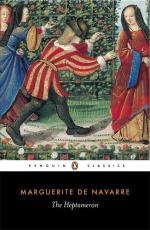Besides writing verses and framing devices, Margaret, as Brantome tells us, “often composed comedies and moralities, which were in those days styled pastorals, and which she had played by the young ladies of her Court.” (2)
1 OEuvres de Brantome, 8vo, vol. vii. p. 567.
2 Ibid., 8vo, vol. v. p. 219.
Hilarion de Coste states, moreover, that “she composed a tragi-comic translation of almost the whole of the New Testament, which she caused to be played before the King, her husband, having assembled with this object some of the best actors of Italy; and as these buffoons are only born to give pleasure and make time pass away, in order to amuse the company they invariably introduced rondeaux and virelais against the ecclesiastics, especially the monks and village priests.” (1)
1 M. Le Roux de Lincy points out that this statement is exaggerated, for Margaret, instead of turning the whole of the New Testament into verse, merely wrote four Mysteries which mainly dealt with the childhood of Christ.
These performances took place at the Chateau of Pau, which Margaret and her husband seem to have preferred to that of Nerac, though political reasons often compelled them to fix their abode at the latter. Pau, however, possessed the advantage of a mild climate, necessary for Margaret’s health, besides being delightfully situated on the Bearnese Gave, the view from the chateau extending over a fertile valley limited by the snow-capped Pyrenees. There had been a chateau at Pau as early as the tenth century, but the oldest portions of the structure now subsisting date from the time of Edward III., when Pau was the capital of the celebrated Gaston-Phoebus. The chateau was considerably enlarged and embellished in the fifteenth century, but it was not until after Margaret’s marriage with Henry d’Albret that the more remarkable decorative work was executed. Upon leaving Nerac to reside at Pau, Margaret summoned a number of Italian artists and confided the embellishment of the chateau to them.(1)
It was not, however, merely the chateau which Margaret beautified at Pau. Already at Alencon she had laid out a charming park, which a contemporary poet called a terrestrial paradise,(2) and upon coming to reside at Pau she transformed the surrounding woods into delightful gardens, pronounced to be the finest then existing in Europe.(3)
1 Some of the doors and windows of the chateau are elaborately ornamented in the best style of the Renaissance, whilst the grand staircase, although dating from Margaret’s time, has vaulted arches, sometimes in the Romanesque and at others in the Gothic style. Entwined on the friezes are the initials H and M (Henry and Margaret), occasionally accompanied by the letter R, implying Rex or Regina. On the first floor of the chateau is the bedroom occupied by Margaret’s husband, remarkable




